https://www.youtube.com/watch?v=thwdEJB-rRo
How to Draw a Panda
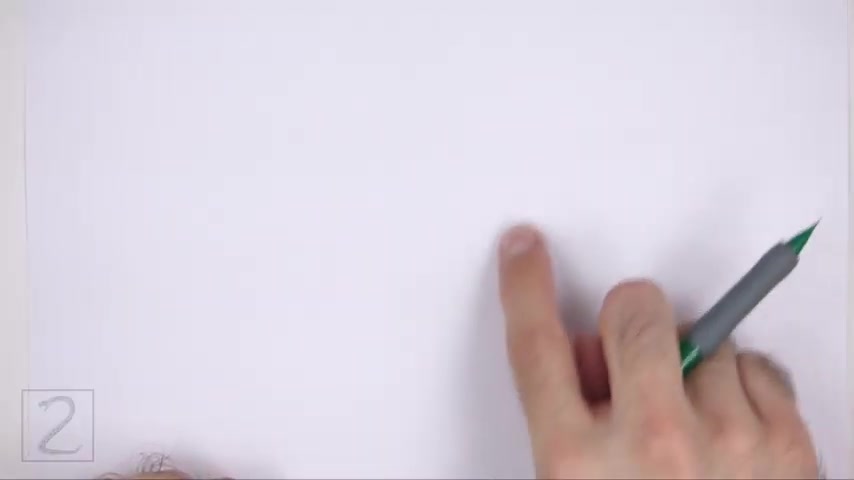
Hello , everyone .
In this video , we're going to draw a panda start by drawing a circle as a guide for the head to draw the circle .
First make two small marks to indicate the circle's length and then on the sides make two more small marks to indicate the circle's width .
Then connect the marks using curved lines to finish the shape of the circle sketch lightly at first so that it's easy to erase .
If you make a mistake , also pause the video to draw at your own pace .
The circle doesn't have to be perfect .
But if you're having trouble drawing it just trace the outer edge of a coin , a bottle cap or anything else with a circular edge , draw a horizontal line across the circle .
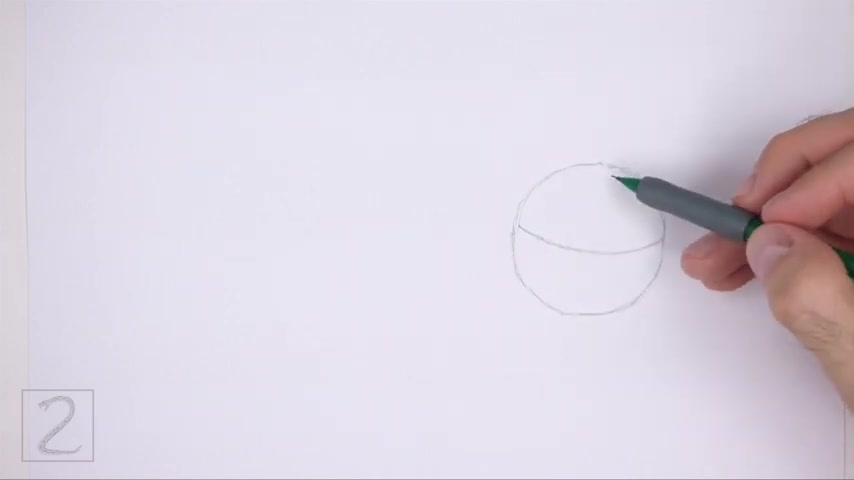
This is a construction guide that will help you place the facial features later on place the line close to the middle of the circle curve , the line so that it contours to the shape of the circle on top of the horizontal guide , draw a short vertical line for another construction guide .
Now draw a small circle on the bottom half of the head as a guide for the muzzle pay attention to the size of the circle in relation to the rest of the head .
The bottom edge of this circle should be outside the bottom edge of the head circle on top of the head , draw two short arcs as guides for the ears , the shape of each ear should be similar to an upside down letter U .
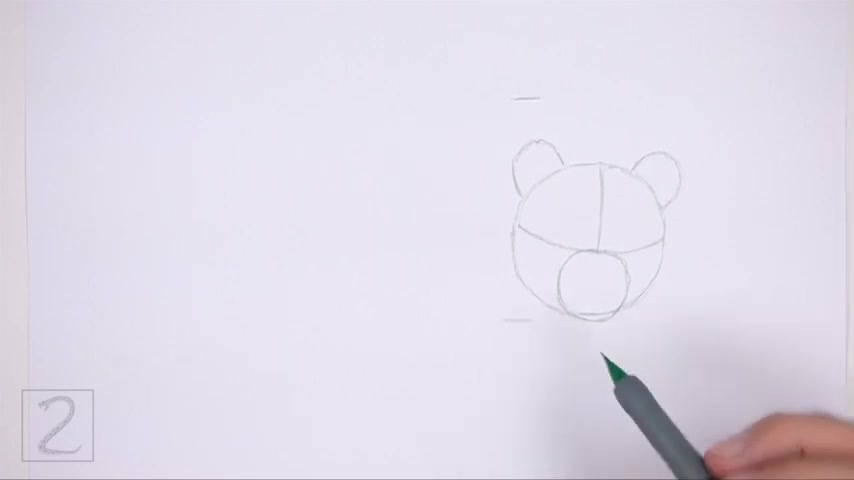
Use the vertical line inside the head as a guide to help you determine the space between the ears to the left of the head drop big circular shape as a guide for the front part of the body to draw this guide first make three small marks to indicate the sides of the shape and then connect the marks using curved lines to finish the shape of the guide .
The shape of this guide is basically a big circle that's partially hidden behind the head .
Pay attention to the size and position of this guide in relation to the head far to the left , draw another circle as a guide for the back portion of the body .
Use the four marks method to draw this circle too .
Don't place this circle too far away or the body will be too long .
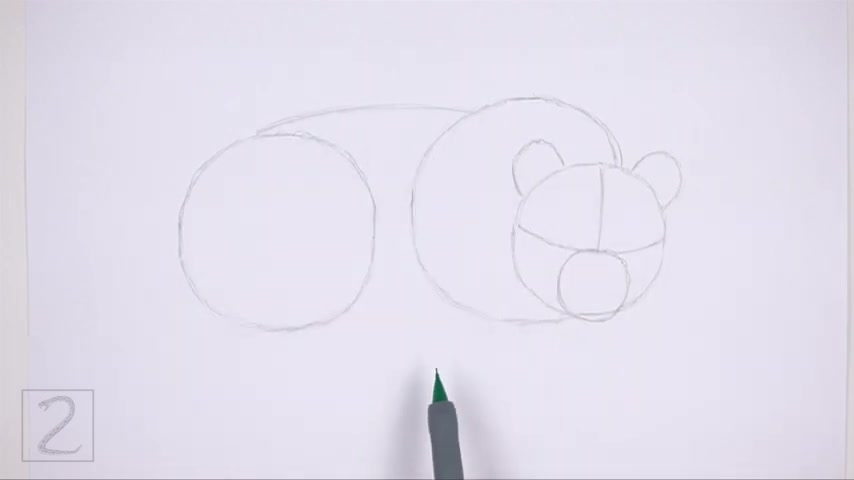
This circle should be about 1.5 times the size of the head circle .
Connect the shapes in the middle using two long curved lines to finish the guy for the torso under the front part of the body , draw two angled lines as guides for the front legs , pandas have short legs .
So don't draw these lines too long .
The bottom parts of the lines will indicate where the feet will be under the back portion of the body draw two more angled lines .
As guides for the hind legs draw these lines slightly shorter than the lines for the front legs .
Each line should be similar to the letter L and that's it for the guidelines .
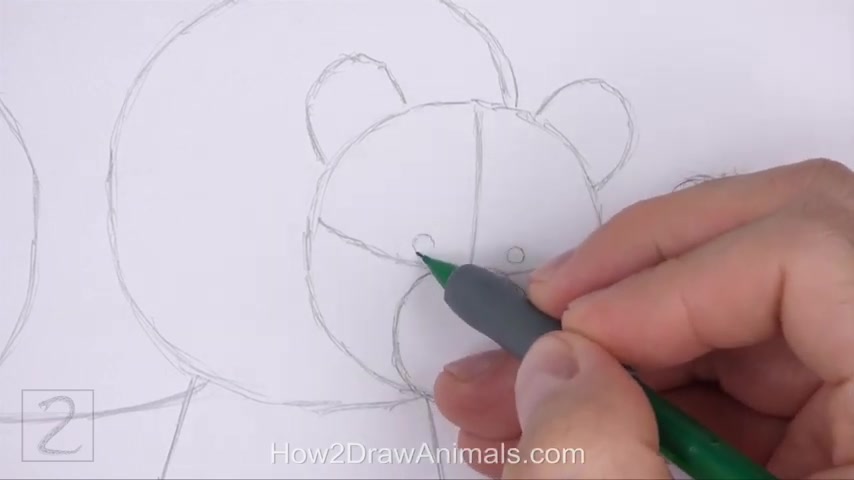
Now , let's start on the final drawing inside the head on top of the horizontal construction guide lightly sketch two small circles for the eyes .
Use the vertical line as a guide to help you determine the space between the eyes .
Draw the eyes very small in relation to the rest of the head .
When you get the size and position of the eyes right darken the shapes as you darken , the shapes make the sides pointier for the corners of the eyes .
The eye on the right should be a bit smaller than the eye on the left because the head is slightly turned , draw a short curved line above each eye for the eyelids add a short curved line below each I two .
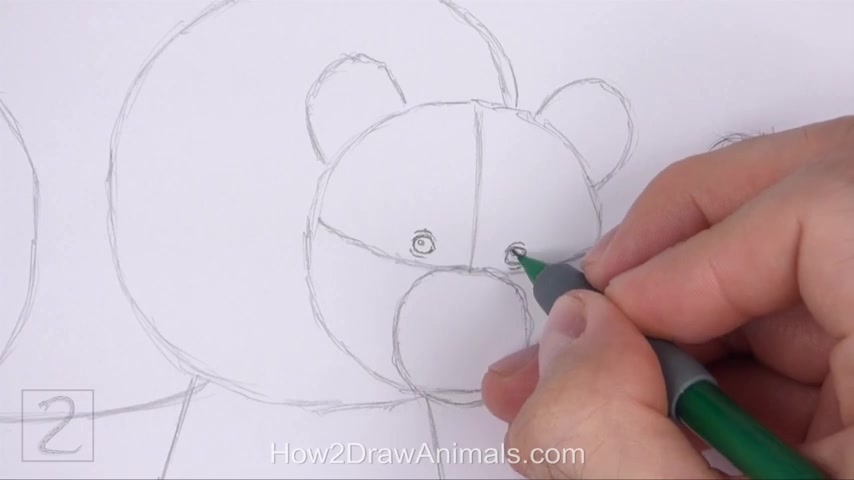
For wrinkles inside the eyes , draw tiny circles for highlights in the middle of each .
I draw a big dot for the pupils .
Now shade in the eyes don't overlap the tiny highlight circles as you shade the eyes use a value that's a bit lighter than the pupils as you shade the eyes inside the small circle near the bottom , lightly sketch a small triangle for the nose , pay attention to the size and position of this shape in relation to the small circle .
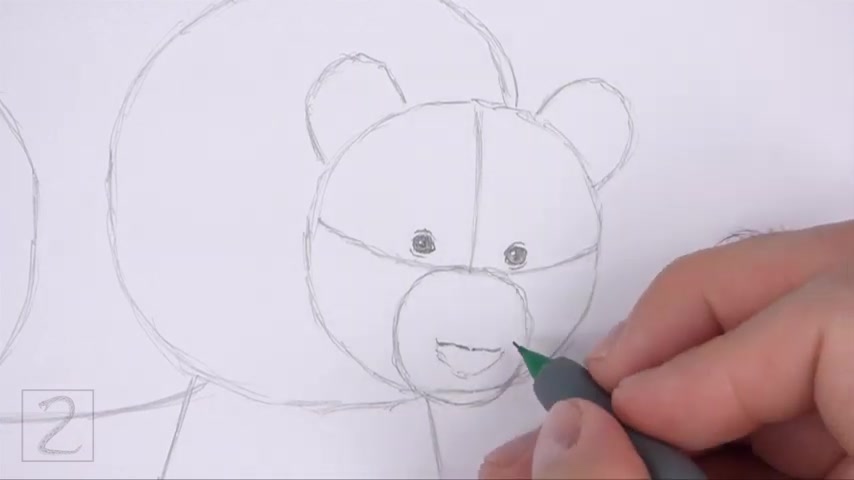
When you get the size and position of this shape , right darken the lines use the wavy line as you darken the top part of the nose , the top corners of the nose should point toward the eyes .
Make the bottom part of the nose rounder as you darken the shape inside the nose on the sides , draw two short curved lines for the nostrils , draw these lines closer together at the bottom , darken the bottom part of each line to make the nostrils bigger .
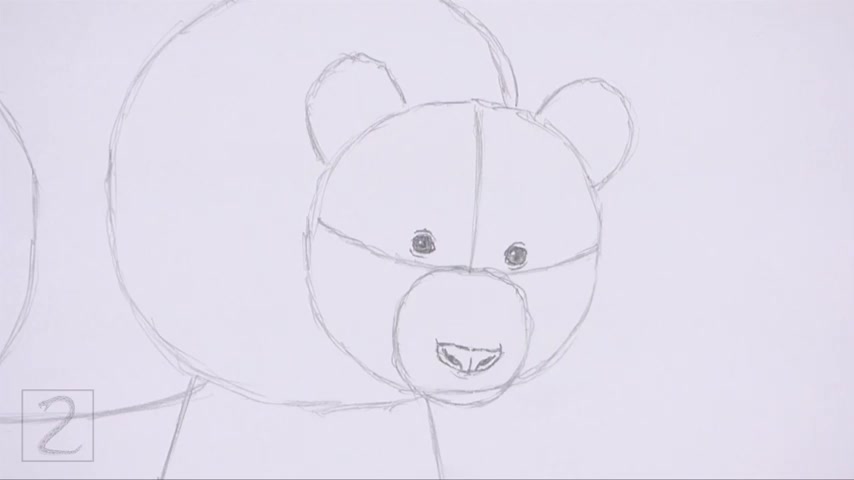
Draw a short vertical line between the nostrils below the nose , draw a line that curves to the right for the first part of the mouth darken the right edge of the small initial circle to create part of the muzzle on the left side , draw another curbed line for the other half of the mouth .
A series of short strokes along the edge of the initial circle .
For the furry muzzle at the top curve , the line slightly to the right , add another short line to the right for the other side of the muzzle , add a series of short strokes along the top to finish the top of the furry muzzle below the mouth , draw a wide curved line that's made up of short strokes for the furry chin .
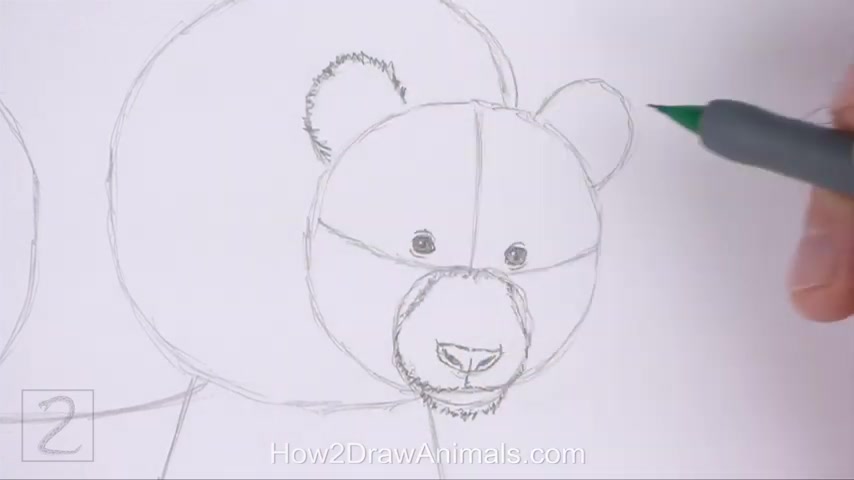
Now use the arc on the top left side of the head as a guide to draw the first ear , a series of short strokes along the path of the arc to create the shape of the furry ear within the arc , draw a small shape that's made up of short strokes for the furry ear opening .
Now use the arc on the right as a guide to draw the other ear the same way darken the path of the arc using a series of short strokes for the fur inside the ar draw more short strokes for the furry ear opening .
Now use the main circle as a guide to draw the rest of the head , draw a series of short strokes along the path of the circle to create the shape of the furry head , make the left side of the head slightly wider than the initial circle change the orientation of the strokes .
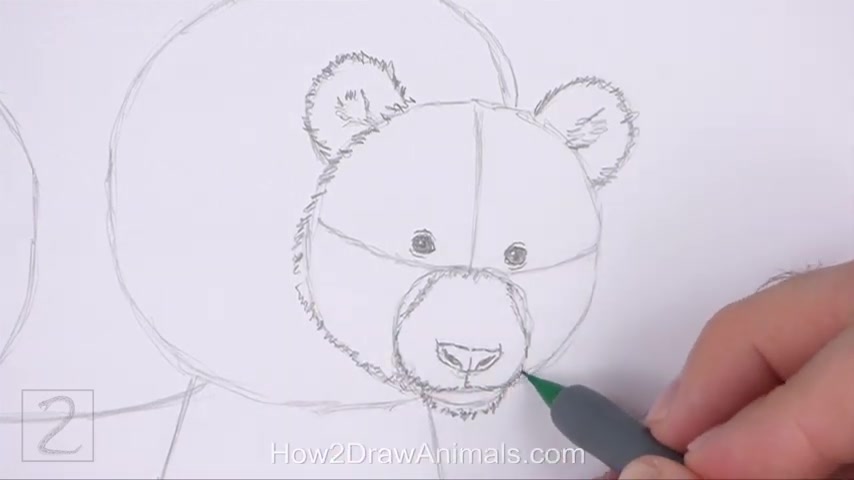
As you follow the path of the circle , the strokes near the middle should have a horizontal orientation and the strokes at the bottom should be vertical , keep the strokes short so that the fur won't be too long .
Make the right side of the head slightly wider than the initial circle too .
Use the second line from the right that's under the body as a guide to draw the first front leg , first lightly sketch the shape of the leg around the guideline , the shape should be wide .
So don't draw the edges of the leg too close to the guideline .
At the bottom curve , the shape to the right along the path of the guide to create the foot .
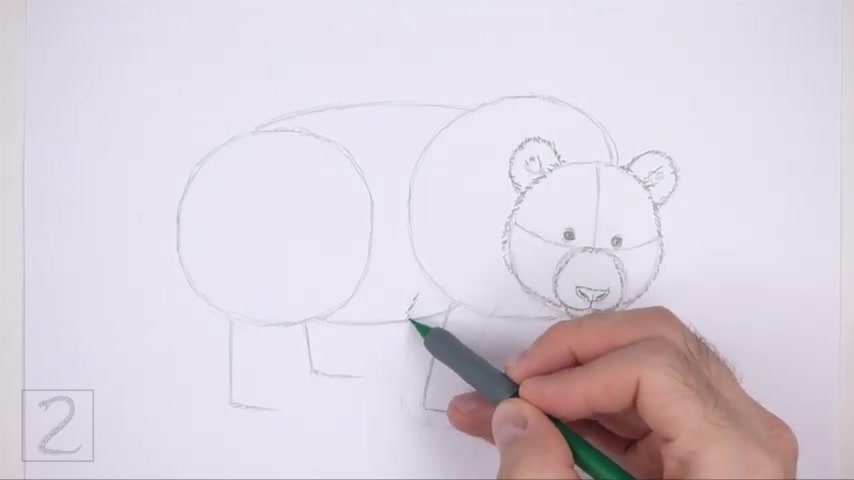
When you get the shape of the leg and foot , right darken the lines use short strokes as you darken the sides of the leg to create a fur texture .
The shape of the leg should be slightly wider at the top than at the bottom along the right edge of the foot .
Draw short curved lines to separate the toes , make the lines at the bottom shorter for the smaller toes .
The bear's fifth toe won't be visible from this angle .
Now use the angled line on the right as a guide to draw the other front leg the same way .
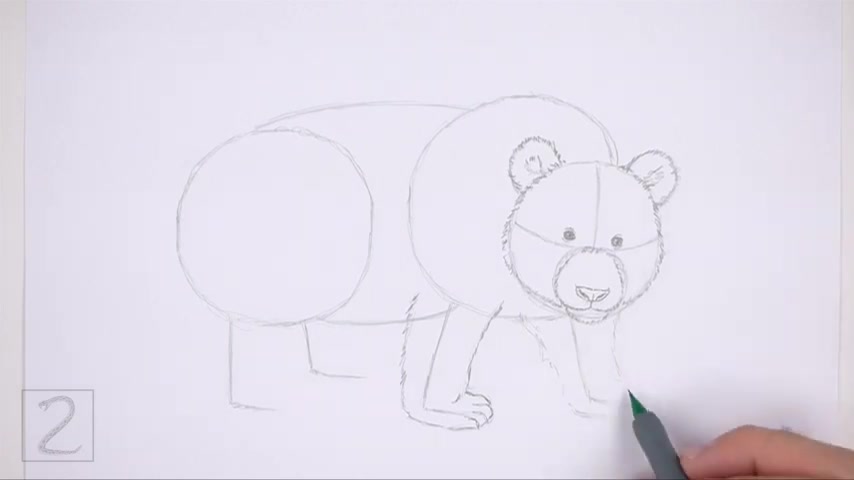
First lightly sketch the shape of the leg around the guideline , make the top part of the leg wide and the bottom narrow at the bottom curve , the shape to the right along the guideline to create the foot .
When you get the shape right darken , the lines use short strokes as you darken the sides of the leg to create a furry texture .
Draw short curved lines along the right edge of the foot to create the toes .
Not all the toes on this foot will be visible from this angle .
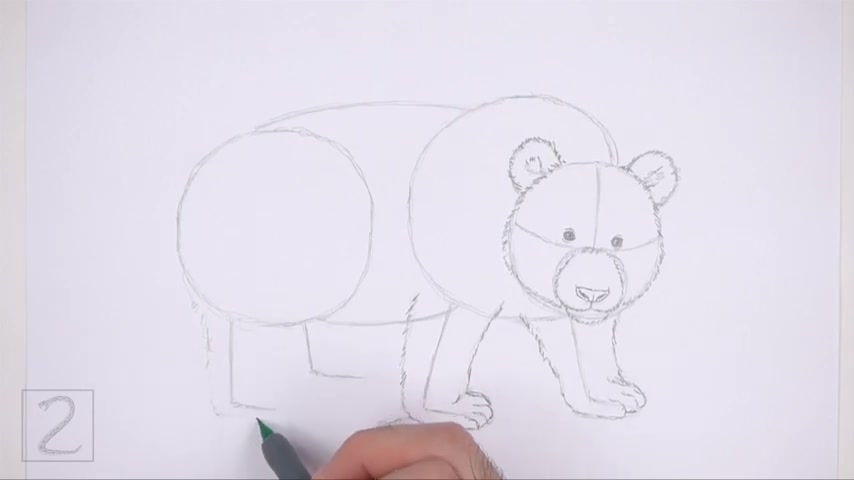
Now use the angled line on the far left side as a guide to draw the first hind leg just like before first lightly sketch the shape of the leg around the guideline , make the top part of the leg wide and the bottom narrow curve the shape at the bottom to create the foot .
When you get the shape of the leg right darken the lines using short strokes to create a furry texture , keep the strokes short so that the fur isn't too long .
Draw a few short curved lines along the right edge of the foot to separate the toes a few short strokes where the leg meets the foot .
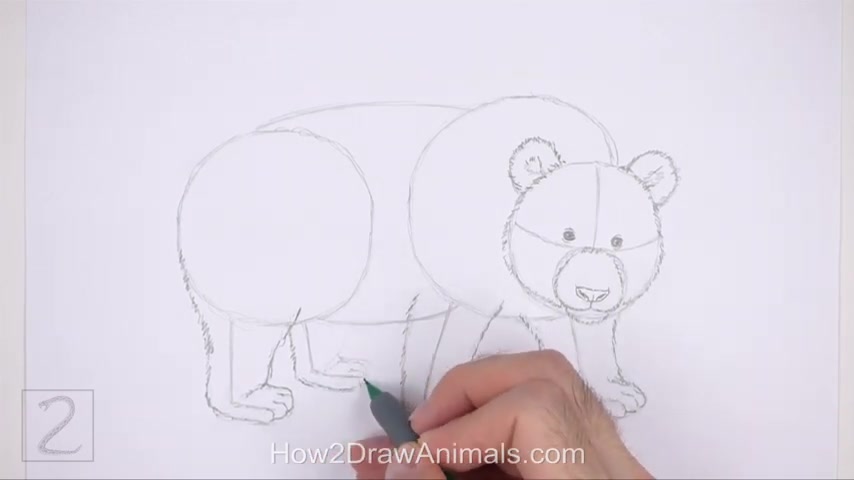
Use the line on the right as a guide to draw the other hind leg .
The same way , draw the shape of the leg and foot around the guideline sketch lightly at first and only darken the lines when you get the shape right , use short strokes for the sides of the leg and curved lines for the toes at the bottom .
Now use the remaining shapes and lines as guides to draw the rest of the body simply darken the outer edges of the guides to create the shape of the body .
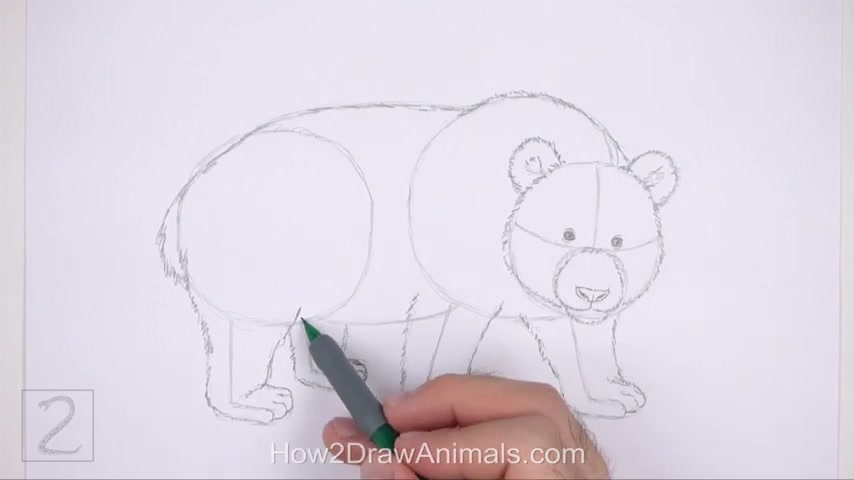
Use a series of short strokes as you darken the guides to create a furry texture on the left side , draw a curved line that's made up of short strokes for the small tail , use slightly longer strokes as you darken the underside of the body for the longer fur found there .
Now erase the initial guidelines .
The next few steps are sped up so that the video won't be too long .
Don't worry about erasing all of the guidelines .
It's ok if you leave some behind , redraw any of the final lines that you may have accidentally erased .
And now add the distinctive panda pattern on the body at short strokes on the tops of the legs and around the eyes to indicate where the dark pattern is on the fur .
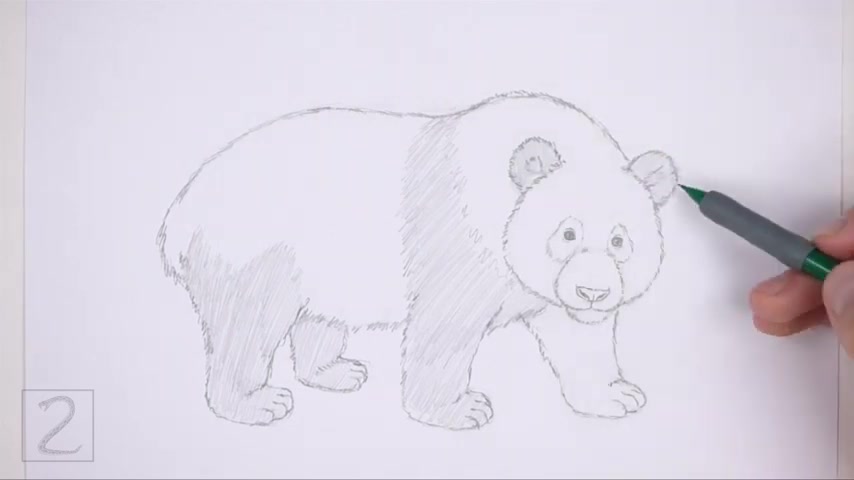
The dark pattern on the front legs reaches all the way to the top and wraps around the back .
Now shade in the shapes for the distinctive panda pattern shade lightly at first and gradually build up to darker values for a light value , push down very lightly on your pencil , then push down harder for darker values .
Use the dark valley for the ears and the nose too .
Without this pattern , pandas are very similar to brown bears .
If you'd like , you can use a medium value all over the body instead of this pattern to create a brown bear instead of a panda , the pattern on the hind leg fades into the white fur at the top .
So gradually add a lighter value at the top .
Now use the medium value on the white bird to create shadows .
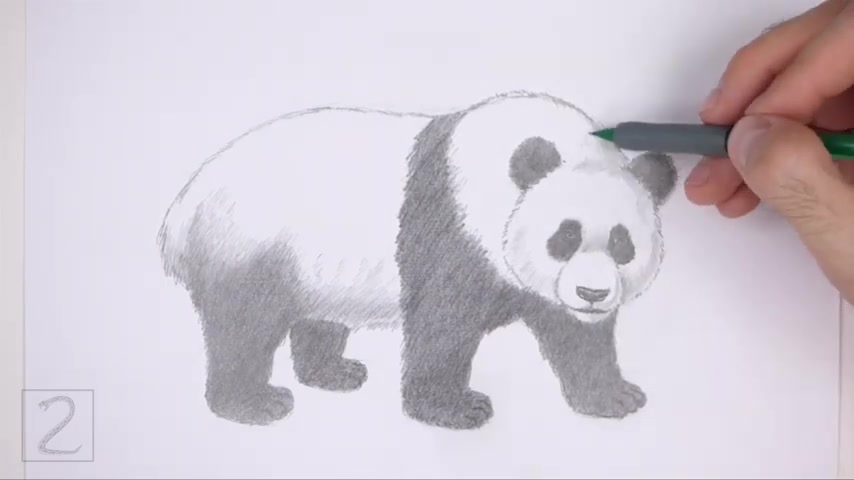
Shadows will give the figure more dimension and volume , separate your strokes as you shade to create a furry texture shading can be time consuming .
So be patient and take breaks .
It's a good idea to use reference as you shade for a more accurate depiction of a panda draw a shadow at the bottom using a medium value .
This grounds the panda so that it doesn't appear to be floating , keep shading until you're happy with the result .
And that's it for the panda .
Don't forget to pause the video to draw at your own pace .
Also , please visit how to draw animals dot com where every step of this tutorial is broken down into an individual image .
That's how and then the number two , then draw animals dot com .
If you enjoyed the video , please leave a like and a comment , also subscribe for more videos in the future .
Thank you for watching .
And until next time , keep drawing .
Are you looking for a way to reach a wider audience and get more views on your videos?
Our innovative video to text transcribing service can help you do just that.
We provide accurate transcriptions of your videos along with visual content that will help you attract new viewers and keep them engaged. Plus, our data analytics and ad campaign tools can help you monetize your content and maximize your revenue.
Let's partner up and take your video content to the next level!
Contact us today to learn more.